Standard [CURRENT]
ASTM F 2656/F 2656M:2023
Standard Test Method for Crash Testing of Vehicle Security Barriers
- Publication date
- 2023
- Original language
- English
- Pages
- 23
- Publication date
- 2023
- Original language
- English
- Pages
- 23
- DOI
- https://dx.doi.org/10.1520/F2656_F2656M-23
Product information on this site:
Quick delivery via download or delivery service
Buy securely with a credit card or pay upon receipt of invoice
All transactions are encrypted
Short description
1.1 This test method provides a range of vehicle impact conditions, designations, and penetration performance levels. This will allow an agency to select passive perimeter barriers and active entry point barriers appropriate for use at facilities with a defined moving vehicle threat. Agencies may adopt and specify those condition designations and performance levels in this test method that satisfy their specific needs. Agencies may also assign certification ratings for active and passive perimeter barriers based on the tests and test methodologies described herein. Many test parameters are standardized to arrive at a common vehicle type and mass, and replication, and produce uniform rating designations. 1.2 Compliance with these test procedures establishes a measure of performance but does not render any vehicle perimeter barrier invulnerable to vehicle penetration. Caution should be exercised in interpreting test findings and in extrapolating results to other than test conditions and to user site conditions. This standard does not confirm the performance of the test barrier in the user site conditions. While computer simulations are powerful tools that are useful in the development of new and improved barriers or in estimating performance under differing conditions, the analytical models and methods must be validated against physical test data. When performing a test, developers and users are encouraged to address specific or unusual user site conditions as needed. 1.2.1 Often local terrain features, soil conditions, climate, or other items will dictate special needs at specific locations. Therefore, if user site conditions are likely to degrade a barrier's performance, the agency in need of a vehicle perimeter barrier should require testing with the specific user site conditions replicated for full-scale crash testing or numerical simulations that explicitly represent the user site conditions and have demonstrated connection to the "as-tested" soil configuration. For example, if the user site conditions are expansive clays, one could obtain user site materials and provide those to the test lab for the full-scale crash test. 1.3 Product/design certification under this test method only addresses the ability of the barrier to withstand the impact of the test vehicle. It does not represent an endorsement of the product/design or address its operational suitability. 1.4 The values stated in either SI units or inch-pound units are to be regarded separately as standard. The values stated in each system may not be exact equivalents; therefore, each system shall be used independently of the other. Combining values from the two systems may result in non-conformance with the standard. 1.5 This test method is intended to replace all previous versions of the test method for current and future testing. 1.6 This standard does not purport to address all of the safety concerns, if any, associated with its use. It is the responsibility of the user of this standard to establish appropriate safety, health, and environmental practices and to determine the applicability of regulatory limitations prior to use. 1.7 This international standard was developed in accordance with internationally recognized principles on standardization established in the Decision on Principles for the Development of International Standards, Guides and Recommendations issued by the World Trade Organization Technical Barriers to Trade (TBT) Committee.
ICS
93.080.30
DOI
https://dx.doi.org/10.1520/F2656_F2656M-23
Also available in
Loading recommended items...
Loading recommended items...
Loading recommended items...
Loading recommended items...

